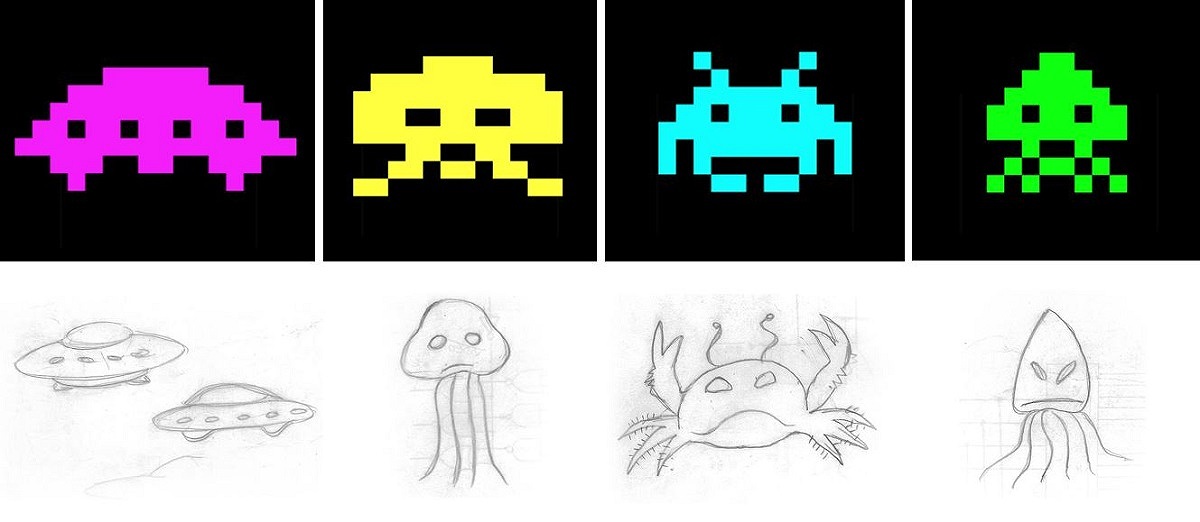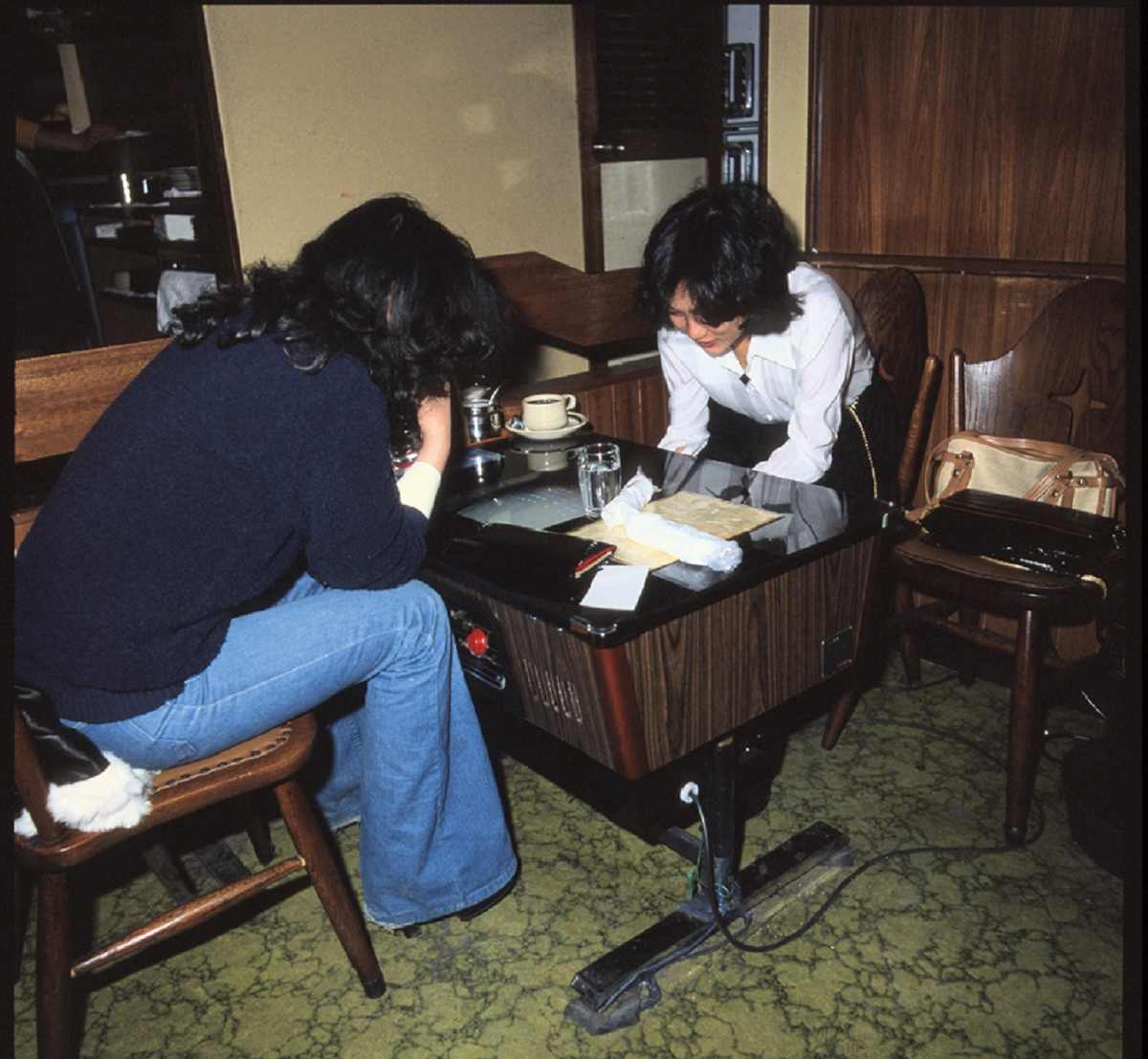
In this combination of partially modified images, pixelated invaders — from left, a UFO, an octopus, a crab and a squid — are seen top, while their sketches are seen below. All of them were created by Tomohiro Nishikado.
12:30 JST, September 24, 2023
The “Space Invaders” arcade game this year celebrated its 45th anniversary. The popular shooting game was widely seen at game arcades and coffee shops in the Showa era (1926-1989), and the game’s distinctive pixelated invaders have been loved for generations. The classic game continues to evolve, and a new version utilizing the latest technology was launched this summer.
“The poor graphics allowed people to enjoy playing the game while imagining aliens,” said Tomohiro Nishikado, who created the “Space Invaders” game. He now serves as an advisor for Taito Corp., a game maker based in Shinjuku Ward, Tokyo.

Tomohiro Nishikado plays “Space Invaders.”
In “Space Invaders,” players fire projectiles while moving a cannon from side to side to shoot alien invaders. The game was originally played with a joystick and buttons located on the side of a table with an integrated arcade game machine. The electronic sounds made when the player shoots invoke nostalgia.
Released in 1978, “Space Invaders” proved enormously popular, especially among young people. The game was available in two types: the upright arcade machine designed for people to play while standing, and a table arcade machine allowing people to sit and enjoy the game while dining at eateries.

Customers play “Space Invaders” at a cafe in 1978.
Table-type arcade games started appearing in 1977. Taito initially focused on partnering with eateries through jukebox leasing. However, jukeboxes began to fade in popularity with the spread of cable broadcasting in the first half of the 1970s. Karaoke machines that used 8-track tapes, which are larger than cassette tapes, were also being installed in bars.
In order to maintain its relationships with these establishments, the company came up with the idea of combining dining tables with games, which they specialized in. Early models used half of the table for the game, which was then replaced with a model that placed the screen in the middle. One of each type is currently stored at the company’s headquarters.

A retro table game arcade for “Space Invaders” is seen at the headquarters of Taito Corp.
Revolutionary enemy attacks
One of the key elements of “Space Invaders” is the way the enemies attack. In previous games, players competed to shoot enemies within a time limit, and the enemies did not attempt to fire back.
In “Space Invaders,” some players ended up finishing just 10 seconds after they started due to the increased level of difficulty, so the game was not well received by Taito’s executives at the time of its development. Even after the game was unveiled to the public on June 16, 1978, Nishikado was asked by the company to change the game’s ending, which happens when the enemies achieve an “invasion” by reaching the bottom of the screen. He remembers being told that the game shouldn’t end when the player’s cannon is still intact. Despite such criticism, the game ended up remaining unchanged. Nishikado said that the “thrill” of this challenge led the game to become a hit.
Some regrets
Distinctive enemy characters such as crabs, octopuses, squids and UFOs were designed by Nishikado. He drew inspiration for them from octopus-like Martians that appear in the science fiction novel “The War of the Worlds” by British author H.G. Wells, which led to the design of the “blue crab” and “green squid” characters. Among these enemies, Nishikado said the crab is the most popular character. At the time, computer graphics were not as good as they are today, so there were limits on what was possible. “That is why the players were able to picture aliens in their minds while playing the game,” he said.
He was disappointed, however, that he couldn’t make the enemies’ eyes glow red due to technical limitations.
As the game became more and more popular, some amusement facilities across the nation were turned into “Invader Houses,” where only “Space Invaders” machines were installed. However, this boom soon died down, partly due to widespread cheating that saw people trying to play multiple times for free. Some boards of education also voiced concerns that the game had a negative impact on children. Rival companies also began to introduce competing products, and the popularity of “Space Invaders” began fading rapidly around the summer of 1979.

“Space Invaders World Defense,” a free smartphone game released this summer
Staying retro
Even nearly half a century after its release, various “Space Invaders” products continue to be developed. Taito launched a new game this summer that uses augmented reality technology provided by Google. The immersive game allows players to battle enemies that appear in the real world on their smartphone screens. The company says players can experience a game which introduces new technological elements to a classic game that can be enjoyed worldwide. The once pixelated invaders have continued to evolve while retaining their retro stylings.
"Society" POPULAR ARTICLE
-

M4.9 Earthquake Hits Tokyo, Neighboring Prefectures
-

Israeli Tourists Refused Accommodation at Hotel in Japan’s Nagano Pref., Prompting Protest by Israeli Embassy and Probe by Prefecture
-

M7.5 Earthquake Hits Northern Japan; Tsunami Waves Observed in Hokkaido, Aomori and Iwate Prefectures
-

Tsukiji Market Urges Tourists to Avoid Visiting in Year-End
-

High School in Kyoto Says Students Shoplifted during Recent School Trip to Bali, Indonesia
JN ACCESS RANKING
-

Tokyo Economic Security Forum to Hold Inaugural Meeting Amid Tense Global Environment
-

Keidanren Chairman Yoshinobu Tsutsui Visits Kashiwazaki-Kariwa Nuclear Power Plant; Inspects New Emergency Safety System
-

Imports of Rare Earths from China Facing Delays, May Be Caused by Deterioration of Japan-China Relations
-

University of Tokyo Professor Discusses Japanese Economic Security in Interview Ahead of Forum
-

Japan Pulls out of Vietnam Nuclear Project, Complicating Hanoi’s Power Plans























